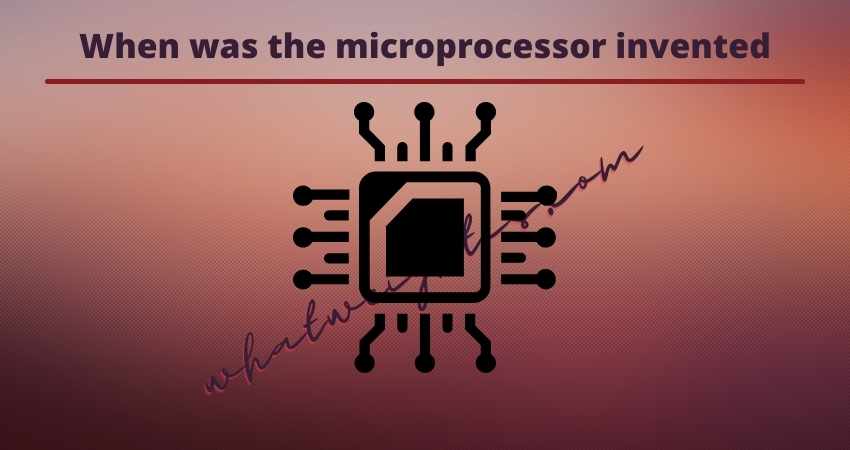The microprocessor, a major technological achievement of the modern era, has transformed our lifestyles and careers. The utilisation of this tiny silicon component to power computers, smartphones, household appliances, and other modern devices has changed our society. The question concerns the microprocessor’s invention and the advancements it sparked, which still shape society. This article explores the microprocessor’s history and its impact on modern digital civilization.

Emergence of microprocessor
The microprocessor originated in the early 1970s, when massive computers filled rooms. In 1971, Robert Noyce and Gordon Moore’s semiconductor business Intel Corporation unveiled the Intel 4004 CPU, a turning point. Federico Faggin’s 4004 integrated 2,300 transistors into a microprocessor, demonstrating excellent engineering. This differed from the usual practise of using separate parts for computing functions.
Modern applications’ complex requirements were not considered when designing the Intel 4004. Its main function was supporting calculators and other basic devices. However, this technology laid the groundwork for a revolution in computers. The speed at which microprocessors execute instructions and calculate has enabled the development of more advanced and capable computers.
What is the weight of bridgeport mill?
Microprocessor evolution
The Intel 4004 microprocessor accelerated microprocessor technology. Intel then introduced the 8008 and 8080 microprocessors, which improved performance and functionality. Computer systems and arcade games used the first microprocessors. The 1978 Intel 8086 microprocessor was a major achievement. The event marked the birth of the x86 architecture, which dominated computing for years. The first 16-bit microprocessor, the 8086, could handle much larger data segments than its predecessors. The architectural architecture above shaped personal computing devices and operating systems like MS-DOS.
Over time, microprocessors have evolved rapidly. The 1980s saw the Intel 80286 and 80386 CPUs, which improved performance and functionality. The 80386 marked a major transition to a 32-bit architecture, enabling faster processing and memory access. The 1990s saw the Pentium series of microprocessors, which strengthened Intel’s market position. Meanwhile, other manufacturers like AMD (Advanced Micro Devices) developed, creating a competitive environment that encouraged innovation and led to processors with higher clock rates and performance.
The Millennium Era and Later Periods
The millenium saw the rise of multi-core CPUs, a milestone in microprocessor history. Intel and AMD have integrated multiple processing cores into a single chip to improve computational performance, rather than boosting clock speeds. The use of this technology enabled parallel processing, which improved performance and allowed simultaneous execution of multiple tasks. With the exponential rise in mobile computing, a microprocessor classification for smartphones and tablets emerged. Qualcomm and Apple make portable device CPUs tuned for battery life and performance. This transition marked a new era in computers as mobile devices became essential to our daily lives.
Anticipating Microprocessor Futures
The evolution of microprocessors indicates no slowdown. In the 21st century, many variables are affecting microprocessor technology. The quest for smaller, more efficient microprocessors continues with miniaturisation. Miniaturisation lets devices with solid processing functions become smaller, enabling the growth of the Internet of Things (IoT) and wearable technology. Artificial intelligence and machine learning have led to the development of specialised processors to speed up and improve these complex computations. AI-focused microprocessors can advance driverless cars, medical diagnosis, and natural language processing.
Quantum computing, unlike classical microprocessors, has the ability to solve computational problems that conventional computers cannot. Quantum computers can improve cryptography, optimisation, and scientific simulations by using quantum physics. Neuromorphic computing uses the brain’s complicated structure and functionality to create computers with neural networks. These processors can create efficient and adaptive computer systems that can perform complex tasks well.
In conclusion, the information suggests the user’s
In the early 1970s, the microprocessor started a technological revolution that still shapes society. The microprocessor has evolved from its early use in calculators to its essential role in modern computers. Computing technology’s breakthroughs in processing power, architectural alterations, and new designs have shaped the digital age.
In this age of technological progression, the microprocessor’s trajectory is a testament to human invention and our continuous quest of progress. From the Intel 4004 microprocessor to multi-core processors and quantum and neuromorphic computing, the microprocessor’s story shows our extraordinary trajectory of invention, innovation, and consequentiality.
Mr. Jahangir Alam is an Electrical & Electronics Engineer with a wide range of experience in several fields of Engineering. He finds engineering articles to be very interesting, and that is why he likes to write them. To know more about him, please click here.

